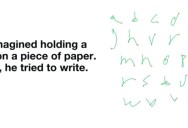Brain Implant Allows Paralyzed Man To Translate His Thoughts Into Handwriting and Text
Researchers at Stanford University discovered that a brain-computer interface (BCI) that uses AI software can be implanted into the brain to allow people who are paralyzed or missing limbs text, write, and type using only their thoughts.
The people behind the study said,
“Here we developed an intracortical BCI that decodes attempted handwriting movements from neural activity in the motor cortex and translates it to text in real time, using a recurrent neural network decoding approach.
With this BCI, our study participant, whose hand was paralysed from spinal cord injury, achieved typing speeds of 90 characters per minute with 94.1% raw accuracy online, and greater than 99% accuracy offline with a general-purpose autocorrect.”

Photo Credit: YouTube
Doctors and team members involved with the study are excited about the progress so far.
They said,
“This approach allowed a person with paralysis to compose sentences at speeds nearly comparable to those of able-bodied adults of the same age typing on a smartphone.
The goal is to restore the ability to communicate by text.”

Photo Credit: Erika Woodrum
The team added that they intend “to work with a participant who cannot speak, such as someone with amyotrophic lateral sclerosis, a degenerative neurological disorder that results in the loss of movement and speech. The new system could potentially help those suffering from paralysis caused by a number of conditions.”
This is a truly remarkable breakthrough!
Take a look at the video below to see how this incredible research unfolded.

Sign up to get our BEST stories of the week straight to your inbox.




